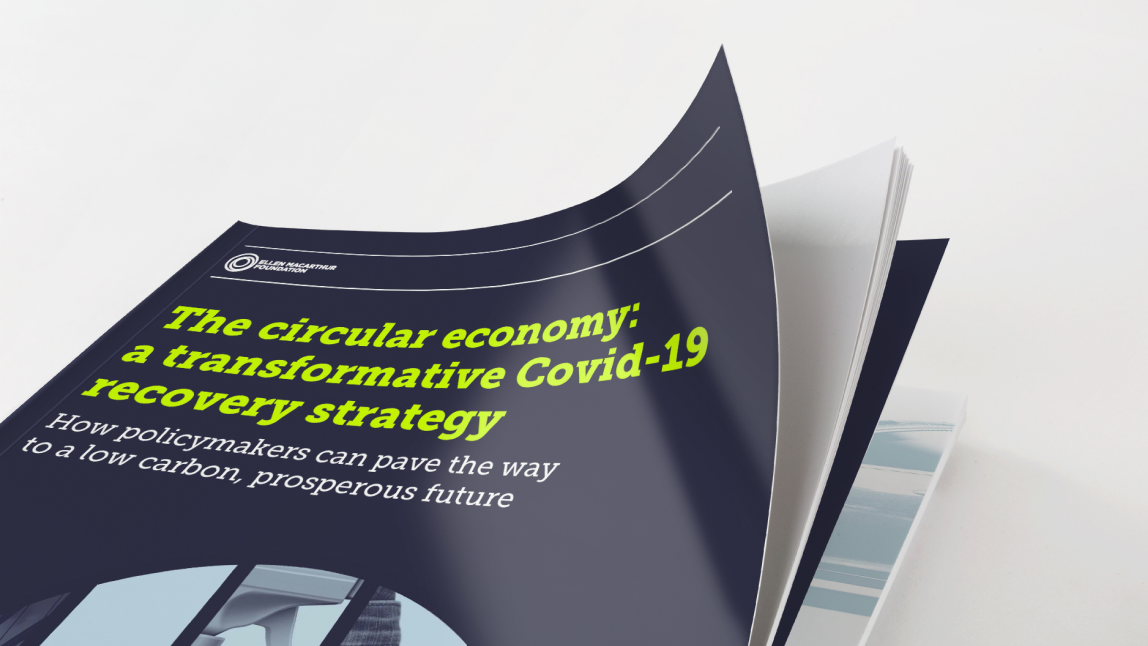Unlocking circular investment opportunities to meet key public priorities
All aspects of finance will play an important role, not only in the immediate response to the Covid-19 crisis, but also in the recovery phase, supporting the transition to a more resilient economy. Investors, banks, and other financial services firms have the scale, reach, and expertise to support businesses to make the shift towards a circular economycircular economyA systems solution framework that tackles global challenges like climate change, biodiversity loss, waste, and pollution. It is based on three principles, driven by design: eliminate waste and pollution, circulate products and materials (at their highest value), and regenerate nature.. This is not just about investing in perfectly circular companies or divesting from extractive ones, but about engaging and stimulating all companies, across industries, in their transition. Governments, central banks, and financial regulators will complement and enable the private sector shift. As highlighted in a recent study published by the Ellen MacArthur Foundation, Financing the circular economy: capturing the opportunity, the market for financing the circular economy is rapidly taking off with early examples showing how investors, banks, and insurers are already capturing these opportunities across asset classes and economic sectors. For example, while no such fund existed in 2017, in the past three years ten public equity funds focusing partially or entirely on the circular economy have been launched by leading providers including BlackRock, Credit Suisse, and Goldman Sachs.
Governments and financial institutions can offer direct financial support for circular economy activities and breakthrough innovations that contribute to shaping a more resilient post-Covid-19 future. Governments can align taxes and subsidies to promote growth and employment in ways that favour a circular economy approach as discussed in the section above on ‘Shaping incentives to enable a low-carbon economic recovery’. However, public institutions can also invest directly in certain economic activities and sectors, including by issuing loans and guarantees at favourable rates, setting price controls, and providing resources like land and water at below-market rates. Some countries, like the UK, are considering setting up a state-backed Green Investment Bank 2.0 to ensure the government-led recovery from the Covid-19 lockdown keeps the country on track with its climate goals, while also generating thousands of jobs. Another example is the European Investment Bank (EIB), which has highlighted the important role that the circular economy plays in the Covid-19 economic recovery. The support around a more circular economy was already set in motion prior to the pandemic, with the EIB launching a Joint Initiative on the Circular Economy making EUR 10 billion in investments available from 2019 to 2023. The initiative will provide “loans, equity investment, or guarantees to eligible projects, and develop innovative financing structures for public and private infrastructure, municipalities, private enterprises of different size, as well as for research and innovation projects”. Recently, the EIB has also launched a new guidance for supporting the transition, which—in addition to setting eligibility criteria for financing—includes a revised section on circular economy categories and project types, a new section for cities, and additional case studies.
“We need to be bold, and invest in a green and circular recovery. Taken together, the Green Deal and the circular economy action plan show us exactly what needs to be done. They are like a powerful vaccine that can help us become more resilient and protect us when other crises will appear or existing ones may worsen. The transformation is already under way, and businesses, consumers and public bodies are endorsing and supporting the sustainable model. It will be vital to draw on that momentum, and use the circular economy to define a new structure for rebuilding the economy.”
In response to the crisis, central banks can explore the possibility of adjusting their bond-buying activities and financial modelling practices to support the transition to a circular economy. While the less conventional method of quantitative easing has its limits in the current low-interest situation—and its effectiveness to stimulate the economy is still debated,—central banks could potentially explore green quantitative easing. It could act as a tool to help lower the cost of borrowing for circular economy projects, as well as stimulate central banks to buy more green bonds with positive environmental impacts. For example, the circular economy could be considered as a key delivery mechanism in the European Central Bank’s examination of using its trillion-euro asset purchase scheme to pursue green objectives, or the European Banking Authority’s work on a green supporting factor. More broadly, central banks and financial regulators could also benefit from integrating not only climate change into their risk assessments and financial modelling, but also the potential of the circular economy to address these risks. In fact, the circular economy could inform scenario analyses on fundamental solutions, such as the redesign of products and services, that complement the current focus on supply-side changes, with demand-side measures (e.g. car electrification versus car-sharingsharingThe use of a product by multiple users. It is a practice that retains the highest value of a product by extending its use period. models).
Investments through public procurement will be vital tools for the rebuilding of societies and economies during the recovery phase. As governments look to rebuild their societies and economies, after having addressed the immediate emergency response, there is an opportunity to leverage public procurement—that makes use of circular economy criteria—to help shape a recovery that is more prosperous, low-carbon, and resilient. The circular economy acts in this respect as a key delivery mechanism by keeping materials in use which reduce resource dependency, lower emissions, and increase resilience (through diversified supply chains). Given governments’ large purchasing powers, making it mandatory in tenders for public procurement to use, for example, recycled materials that are compatible with a circular economy, can create demand and accelerate the transition.
More broadly, such measures can make circular designs and business models the default options in public procurement, strengthening the demand for circular economy products and services, as well as for more flexible buildings and infrastructure designs. As an example, Amsterdam has developed its Roadmap for Circular Land Tendering that includes 32 performance-based indicators for circular economy building developments. The city developed such a circular land tender process in the Zuidas area where a multifunctional mixed-use building will be designed to include a material passport, reclaimed resources, and design for disassembly, alongside the highest BREEAM sustainability standard. At a European level, the European Commission is setting out several actions in the Circular Economy Action Plan to help facilitate the integration of circular economy principles in public procurement.
In addition, governments and financial regulators can enhance transparency by providing standardised definitions and metrics for circular economy investments that contribute to a low-carbon economic recovery. A good example is the common classification system or ‘taxonomy’ under development in the EU which is being created to encourage private investment in sustainable growth and a climate neutral economy. Providing policymakers, businesses, and investors with a common language on circular economic activities that substantially contribute to a low-carbon and resilient recovery, can help scale the efforts of all stakeholders involved, track progress, and eventually evaluate the impacts achieved. As such, the EU's recovery plan will now be guided by a green finance taxonomy, where the circular economy features. Moreover, such a system could also be of particular use in blended finance solutions where public and private capital come together to help fund circular economy infrastructure and innovation.
In the recovery phase, investment in specific sectors and areas will critically be needed to help shape a more prosperous and resilient economy. Yet, even in the EU, where its Green Deal is seen as the “motor of the recovery”, there are to date few concrete investment plans in place despite the wealth of opportunities. In light of this, the European Commission has stressed that "clearer and stronger investment signals are urgently needed for today’s investment planning and decisions to be coherent with the transition to climate neutrality”. To help ensure investments can be directed towards areas that can help achieve a resilient economic recovery that also tackles environmental challenges, the Ellen MacArthur Foundation presents ten attractive circular economy investment opportunities that spread across five key sectors.













